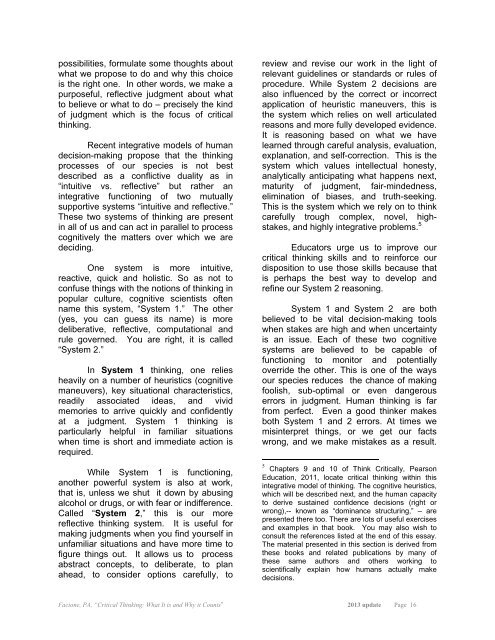Critical Thinking: What It Is and Why It Counts - Insight Assessment
Critical Thinking: What It Is and Why It Counts - Insight Assessment
Critical Thinking: What It Is and Why It Counts - Insight Assessment
Create successful ePaper yourself
Turn your PDF publications into a flip-book with our unique Google optimized e-Paper software.
possibilities, formulate some thoughts about<br />
what we propose to do <strong>and</strong> why this choice<br />
is the right one. In other words, we make a<br />
purposeful, reflective judgment about what<br />
to believe or what to do – precisely the kind<br />
of judgment which is the focus of critical<br />
thinking.<br />
Recent integrative models of human<br />
decision-making propose that the thinking<br />
processes of our species is not best<br />
described as a conflictive duality as in<br />
“intuitive vs. reflective” but rather an<br />
integrative functioning of two mutually<br />
supportive systems “intuitive <strong>and</strong> reflective.”<br />
These two systems of thinking are present<br />
in all of us <strong>and</strong> can act in parallel to process<br />
cognitively the matters over which we are<br />
deciding.<br />
One system is more intuitive,<br />
reactive, quick <strong>and</strong> holistic. So as not to<br />
confuse things with the notions of thinking in<br />
popular culture, cognitive scientists often<br />
name this system, “System 1.” The other<br />
(yes, you can guess its name) is more<br />
deliberative, reflective, computational <strong>and</strong><br />
rule governed. You are right, it is called<br />
“System 2.”<br />
In System 1 thinking, one relies<br />
heavily on a number of heuristics (cognitive<br />
maneuvers), key situational characteristics,<br />
readily associated ideas, <strong>and</strong> vivid<br />
memories to arrive quickly <strong>and</strong> confidently<br />
at a judgment. System 1 thinking is<br />
particularly helpful in familiar situations<br />
when time is short <strong>and</strong> immediate action is<br />
required.<br />
While System 1 is functioning,<br />
another powerful system is also at work,<br />
that is, unless we shut it down by abusing<br />
alcohol or drugs, or with fear or indifference.<br />
Called “System 2,” this is our more<br />
reflective thinking system. <strong>It</strong> is useful for<br />
making judgments when you find yourself in<br />
unfamiliar situations <strong>and</strong> have more time to<br />
figure things out. <strong>It</strong> allows us to process<br />
abstract concepts, to deliberate, to plan<br />
ahead, to consider options carefully, to<br />
review <strong>and</strong> revise our work in the light of<br />
relevant guidelines or st<strong>and</strong>ards or rules of<br />
procedure. While System 2 decisions are<br />
also influenced by the correct or incorrect<br />
application of heuristic maneuvers, this is<br />
the system which relies on well articulated<br />
reasons <strong>and</strong> more fully developed evidence.<br />
<strong>It</strong> is reasoning based on what we have<br />
learned through careful analysis, evaluation,<br />
explanation, <strong>and</strong> self-correction. This is the<br />
system which values intellectual honesty,<br />
analytically anticipating what happens next,<br />
maturity of judgment, fair-mindedness,<br />
elimination of biases, <strong>and</strong> truth-seeking.<br />
This is the system which we rely on to think<br />
carefully trough complex, novel, highstakes,<br />
<strong>and</strong> highly integrative problems. 5<br />
Educators urge us to improve our<br />
critical thinking skills <strong>and</strong> to reinforce our<br />
disposition to use those skills because that<br />
is perhaps the best way to develop <strong>and</strong><br />
refine our System 2 reasoning.<br />
System 1 <strong>and</strong> System 2 are both<br />
believed to be vital decision-making tools<br />
when stakes are high <strong>and</strong> when uncertainty<br />
is an issue. Each of these two cognitive<br />
systems are believed to be capable of<br />
functioning to monitor <strong>and</strong> potentially<br />
override the other. This is one of the ways<br />
our species reduces the chance of making<br />
foolish, sub-optimal or even dangerous<br />
errors in judgment. Human thinking is far<br />
from perfect. Even a good thinker makes<br />
both System 1 <strong>and</strong> 2 errors. At times we<br />
misinterpret things, or we get our facts<br />
wrong, <strong>and</strong> we make mistakes as a result.<br />
5 Chapters 9 <strong>and</strong> 10 of Think <strong>Critical</strong>ly, Pearson<br />
Education, 2011, locate critical thinking within this<br />
integrative model of thinking. The cognitive heuristics,<br />
which will be described next, <strong>and</strong> the human capacity<br />
to derive sustained confidence decisions (right or<br />
wrong),-- known as “dominance structuring,” – are<br />
presented there too. There are lots of useful exercises<br />
<strong>and</strong> examples in that book. You may also wish to<br />
consult the references listed at the end of this essay.<br />
The material presented in this section is derived from<br />
these books <strong>and</strong> related publications by many of<br />
these same authors <strong>and</strong> others working to<br />
scientifically explain how humans actually make<br />
decisions.<br />
Facione, PA, “<strong>Critical</strong> <strong>Thinking</strong>: <strong>What</strong> <strong>It</strong> is <strong>and</strong> <strong>Why</strong> it <strong>Counts</strong>” 2013 update Page 16


